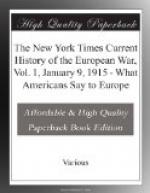A Federation of Europe.
“Certainly I hope that out of the great crime of this vast war some good will come. The greatest good which could come would be a general European federation. I do not believe that this will come at once; but the world will be infinitely the better if it comes at length—if the natural law of mutual attraction for mutual advantage draws these nations now at war into a union which shall make such wars impossible in future, as wars between our States, here, are impossible.
“But before this can come peace must come, and before peace can come one or the other of the nations now at war must at least ask for an armistice.
“If I were in the place of that great General, Lord Kitchener, and should receive the news that such a request had been made by the commander of the opposing forces, I should say: ’No armistice! Surrender!’
“But, then, if the surrender should be made, I should say, in effect:
“’Gentlemen, we have made up our minds that these terrible explosions must mark the end of war between our civilized nations. Our sacrifices in this war have been too great to permit us to be satisfied with less than this.
“’If we now cannot feel assured of such a federation of nations as will result in the settlement of all future disputes by peaceful arbitration at The Hague, then we shall keep on fighting till the day comes when we can achieve that end.
“‘Upon the other side of the Atlantic,’ I should continue if I were Lord Kitchener and should be confronted by such a situation, ’we see in the United States of America an example which must satisfy us that world peace now can be maintained.
“‘There,’ I should go on, ’thirteen States were banded into union in 1776. Their total population was less than the present population of their largest city and their area has spread until it links two oceans and offers homes in forty-eight States to one hundred millions, and the population still increases rapidly. An experiment of world significance was tried, and is a success, for the aggregated nation has grown and now is growing in power more rapidly than any other nation on the surface of the earth.’”
Would Mean World Peace.
“‘It is plain to me and should be plain to all of us,’ I should continue, if I were Lord Kitchener, so placed, ’that we in Europe have but to follow this example which America has set for us in order to achieve an ultimate result as notably desirable. When we have accomplished it world peace will be enthroned and all the peoples of the earth will be able safely to go about the pleasant and progressive business of their lives without apprehension of their neighbors. Humanity, thus freed of its most dreadful burden, will be able to leap forward toward the realization of its ultimate possibilities of progress.’”
“And do you really think there is the immediate possibility of an effective European league for permanent peace and general disarmament?” I asked Mr. Carnegie.




